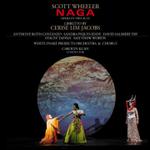|
Back
04/20/2021
Scott Wheeler: Naga
Anthony Roth Costanzo (countertenor), David Salsbery Fry (bass), Stacey Tappan (soprano), Matthew Worth (baritone), Sandra Piques Eddy (mezzo-soprano), White Snake Projects Chorus, Lidiya Yankovskaya (conductor), Boston Children’s Chorus, Michele Adams (conductor), Emily Kang (Children’s Chorus soloist), White Snake Projects Orchestra, Carolyn Kuan (conductor)
Recording: Cutler Majestic Theatre, Boston, Massachusetts (September 15 and 17, 2016) – 90’14
New World Records 80814 – Booklet in English

   
Make no mistake: Scott Wheeler’s opera Naga leaves much to be desired.
In a genre known for needlessly complicated and ridiculous librettos, Naga stands alone. But beyond the absurd plot, repulsive imagery, and pompous delivery, there are some praiseworthy qualities in this story of...well, I don’t really know that it has a story. The plot seems to be a hodgepodge of religious symbols about sacrifice and resurrection in which an asteroid, the goddess Guan Yin, the poetry of William Blake, drowned children, Lord Krishna, a couple of snakes and the Book of Genesis play a role. (Naga is the legendary snake who protected Buddha following his enlightenment.)
Naga would be easy to dismiss except for the miracle of Scott Wheeler’s instrumental music. From the first notes of the “Prelude” to the final “Forgive me, Master” as blood pours from the Master’s wounded side (guess who that is), Wheeler’s music is right there, always engaging, varied and sometimes even delightful, with a variety of percussion instruments and some lyrical passages I would greatly love to hear again. In Track 13 of Act I, a particularly evocative interlude, much too short, recalled Britten’s Peter Grimes.
The ethereal Children’s Chorus passages could easily be molded into a stand-alone selection for youth choir. Throughout the opera, Wheeler’s orchestral writing is saturated with instrumental color, conducted with tenderness and sensitivity by Carolyn Kuan.
The lead singers were professional, with special recognition to countertenor Anthony Roth Costanzo as Xiao Qing, the Green Snake, and Stacey Tappan as the White Snake. High marks for having the role of the female Green Snake, who was the White Snake’s male lover in a previous life, cast in the ambiguous undulations of this countertenor’s voice (and what a great voice it is). Stacey Tappan, soprano, excels in a challenging role, projecting a crystalline quality of purity intermingled with despair. David Salsbery Fry’s articulation as the Abbot was unfailingly lucid and convincing. Some of the singers in this production, however, may have been coached into projecting with aggression and an assertiveness that could at times be grating and seemed out of sorts with the theme of Eastern (or East-West) spirituality.
I might have viewed this opera more favorably if I hadn’t seen the libretto, or if it were in a language I do not understand. Then I would have been spared the lurid references to rats and famine, impaling an unborn child, chopping and hacking (“Hack her, chop, chop, chop!"), wrenching livers and spleens, gouging welts, scorching brains, and other macabre perversions.
The accompanying booklet suggests we should consider Naga with the same welcoming spirit with which we greet Mozart’s The Magic Flute. But there is no comparison. Mozart’s opera is light, entertaining, and life-affirming, rooted in a precise knowledge of Masonic customs and with a sense of humor about itself.
Naga is the first of three operas which constitute The Ouroboros Trilogy. This cycle includes the 2011 Pulitzer Prize-winning opera, Madame White Snake by Zhou Long and Gilgamesh by Paolo Prestini. All three operas have librettos by Cerise Lim Jacobs.
Linda Holt
|